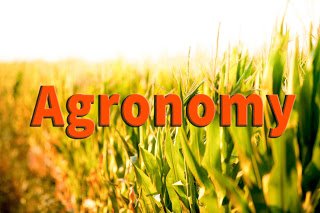Define agronomy with scope and principles
Agronomy
Agronomy is the science of manipulating crop environment complexes with the duel aim of improving crop productivity as well as having a better understanding of the processes involved. The word agronomy has been derived from two Greek words- `agros’ means field and ‘nomos- ‘ means to manage. Literally, it means the art of managing fields and technically it means the science and economics of crop production by management of farmland. In other words it is the art and underlying science in production and improvement of field crops with the efficient use of soil fertility, water, labour and other factors related to crop production. Thus agronomy as a branch of agricultural science deals with principles and practices of field management for the production crops. Among all the branches or agriculture, agronomy occupies a pivotal position and is regarded as the mother or primary branch.
Scope of agrnomy
The central theme of agronomy is of soil-crop-environment relationships. Field crops without soil cannot be considered and soil without crops is barren. The core scope of agronomy lies in the field of crop plant with the theme of controlling the environment (microclimate).
It includes the study of the magnitude of variation in yield, cause and effect relationships, internal and external factors and their interrelationships, techniques of increasing use-efficiency of inputs, evolving technologies for better management practices of soil, water, nutrients, weeds and crop plants are the major aspects of agronomy to boost up production and its usable products per unit land, time and input.
Scientific crop production includes crop improvement improved agro-techniques, the ameliorating agro-climate of the locality and other aspects of the surrounding area for the entire fi duration of crop concerned.
Principle of agronomy
A principle means a scientific law that explains natural action and agronomic principles are the ways and means for the better management of soil, plants and environment for economically maximum returns per unit area.
Principles of crop management depend largely on the type of farming namely, specialized, diversified, mixed and integrated and also on the physical and technological facilities available, irrigated farming, dry farming and rain fed farming.
The fundamental principles of agronomy may be listed as:
1, Planning, programming and executing measures for maximum for utilization of land, labour, capital, sunshine, rain-water, temperature, humidity, transport and marketing facilities.
2. Choice of crop varieties adaptable to the particular agro-climate, land situation, soil fertility, season and method of cultivation and befitting to the cropping system.
3. Proper field management by tillage, preparing field channels and bunds for irrigation and drainage, checking soil erosion, leveling and adopting other suitable land improvement practices.
4. Adoption of multiple cropping and also mixed or intercropping to ensure harvest even under adverse environmental conditions.
5. Timely application of proper and balanced nutrients to the crop or crops in sequence and improvement of soil fertility and productivity. Correction of bad-effects of soil reactions and conditions and increasing soil organic matter through the application of green manure, farm yard manure, organic wastes, biofertilizers and profitable recycling of organic wastes.
6. Choice of quality seed or seed material and maintenance of requisite plant density per unit area with, healthy and uniform seedlings.
7. Proper water management with respect to crop, soil and environment through conservation and utilization of soil moisture as well as by water that is available in excess.
8. Adoption of adequate, need-based, timely and proper plant protection measures against weeds, insect-pests, pathogens, as well as climatic hazards and correction of deficiencies and disorders.
9. Adoption of suitable and proper management practices including intercultural operations to get maximum benefit.
10. Adoption of suitable method and time of harvesting of crop to reduce field-damage and to release land for succeeding crop(s) and efficient utilization of residual moisture, plant nutrients and other management practices.
11. Adoption of suitable post-harvest technologies.
